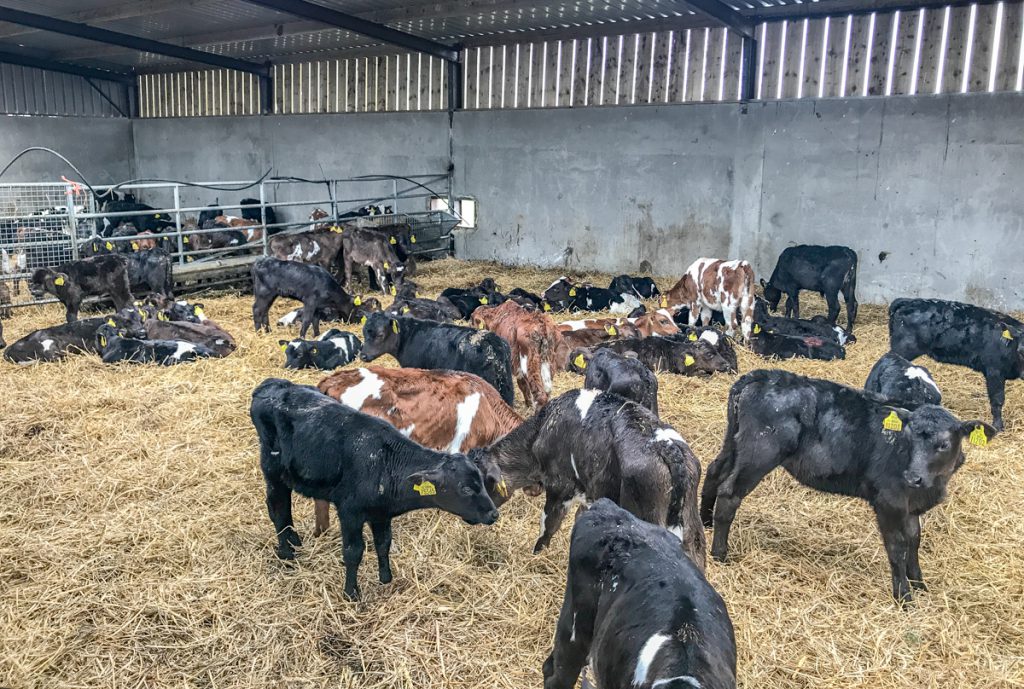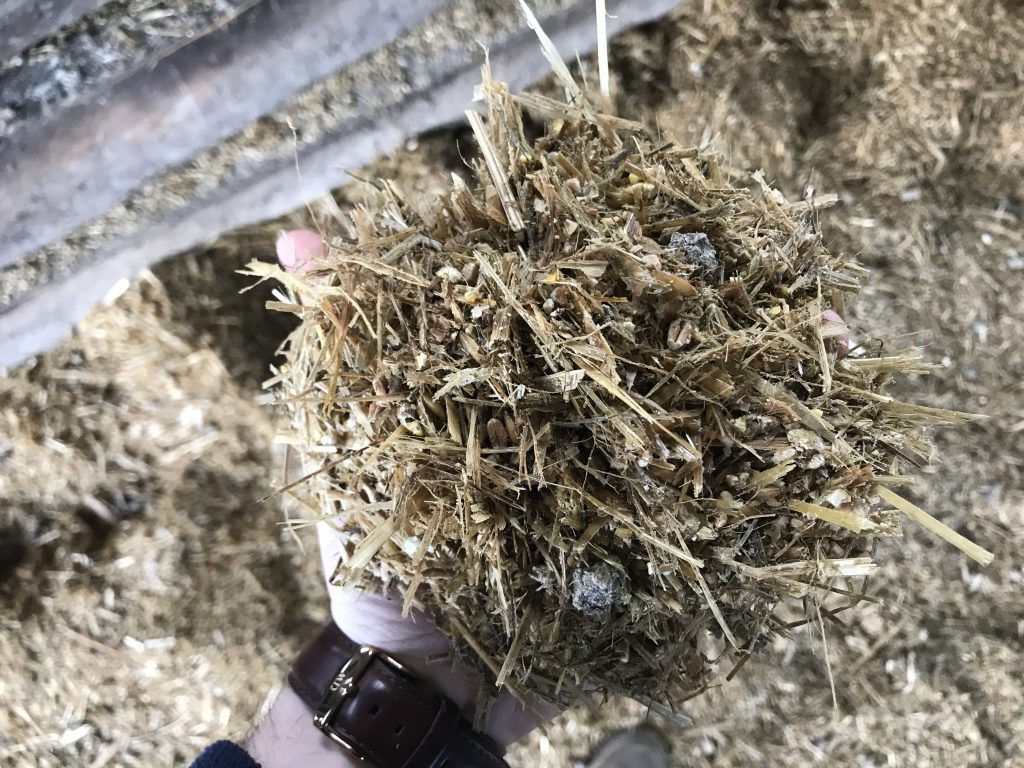Farming in Ballinamore, Killashee, Co. Longford, Philip Stewart, along with his father Derek and uncle Ian, runs a dairy calf-to-beef enterprise; a part-time employee also lends a hand at the weekends.
The Stewarts also run a tillage operation in conjunction with the calf-to-beef enterprise. They also carry out hire work. This includes: silage harvesting; slurry spreading; grain rolling and reseeding.
Unhappy with the financial performance of the farm and upon graduating from Gurteen College in 2016, Philip converted the farm from a suckler-to-weaning enterprise to a calf-to-beef operation.
The total area farmed is 450ac – 250ac in grassland and 200ac in tillage; the majority of the tillage ground is fragmented.
From speaking with Philip, it is quite clear that he is happy with the decision and outlined why the move made financial sense.
He said: “For us, there’s no future for suckler animals. The ground is too heavy and the cost to keep a cow is just way too high.
“It’s just not economical for us. I have all my costings done on how much it costs to rear and finish dairy calves and it makes no sense to be at sucklers,” he explained.
After convincing both Derek and Ian that this was the direction that the farm needed to take, the first wheels were put in motion in 2015 and 320 calves were reared in 2016.
The operation
Calves arrive on the farm at approximately 14 days old. These animals are vaccinated for both pneumonia and scour related diseases; an electric tag is then inserted into the ear of the calf.
Dairy calves are sourced direct from farmers. The disease status is known and only well-reared calves are purchased for the farm.
Philip finishes predominately Friesian bulls; however, other breeds include: Angus; Hereford and Jersey cross animals.
On this, he said: “I don’t have a particular breed preference; I will finish whatever I can. The Jersey cross types obviously have Holstein influence, but I can purchase these for €20/head and get them up towards the €1,000 mark.”
The Stewarts operate two systems; a 16-month bull beef system and a 20-month bull beef system. Sometimes, Angus calves are squeezed depending on the situation on the farm.
Philip added: “Originally, we started off with only a 16-month system, but this didn’t really work. If you experience any bit of a knock, you may forget about finishing them at that age bracket.
“August-born calves are easy enough to finish at 16 months, as they get a full year at grass and they are going in at the right time for finishing; spring calves are a little bit more tricky, so we aim to slaughter these at 20 months.
Automatic feeders
When Philip first made the switch from the suckler-to-weaning enterprise, calves were all fed by hand. This required a lot of work and was very time consuming. However, two automatic feeders have now been installed on the farm.
“At the beginning, I was feeding 280 calves / day and it was taking four hours in the morning and four hours in the evening. It was a complete disaster; feeding calves was all that I was at.
“However, from the minute we put in the first feeder, it went from four hours to one and a half hours. And now, with the second feeder, they would be fed, checked and bedded within an hour,” he explained.
The automatic feeders work in conjunction with the electronic ear tag. The feeder will feed calves 1.5L of milk every four hours and up to 6L/day. If a longer period passes between feeds, the feeder will allocate more milk.
On this, Philip said: “The feeders are a great job. You can change everything. Every night I will go through the computer to see that every calf has got what it was supposed to. For example, it will tell me if a calf has only drank 1L out of 6L and then I can go find that calf and see if there’s anything wrong.
“Calves require a lot of attention. You need to be on the ball with them – especially at a young age. Once they’re over six months old, you’re fairly safe with them.”
Each feeder cost €15,000; four feed stations are located on each one. Philip has provisions in place to install another feeder when he increases calf numbers.
Dealing with difficult ground conditions
The Stewarts – like every other farmer in the country – have felt the effects of the disastrous start to the year. In 2017, cattle were turned out to pasture on February 13. This year, cattle began to hit the driest paddocks around St. Patricks day and the last of the stock were let out on April 10.
“One of the biggest advantages we have is that the cattle are light. They can tip along nicely; it works well with the type of land that we have.
“We have implemented a reseeding plan. We’ve done a good bit of draining and reclaiming to date and the plan is to keep going. We still have a good bit to do, but we’re on the right track.”
Philip aims to prolong the grazing season for as long as possible, as this is the cheapest and most efficient system.
“They will stay on grass for as long as possible. As long as there is grass and the weather isn’t too hard on them, they will be out. The plan was to out-winter some cattle on rape this year, but the way that the winter came we were forced to house.”
Cattle receive a Blackleg vaccination as they go out to grass. They also receive a copper bolus and a vitamin bolus. The animals are treated for fluke twice over the summer months and then again at rehousing.
The silage ground was grazed and fertilised on March 17. The aim is to harvest the first cut of silage at the end of May. In total, 134ac will be harvested over two cuts; 100ac of wholecrop will also be made. Any paddocks that go too strong will be taken out for bales.
Feeding, finishing and factory grading
The farm is fully self sufficient; crops include: barley (treated with Maxammon); crimped wheat; wholecrop; and oats. Beans are normally sown on the farm. However, with the inclement weather experienced this year, no beans were planted.
“We sold barley this year and if we didn’t, we would have had enough to carry us through. We also keep all our own straw; the only thing we buy is the molasses.”
By the end of 2018, approximately 450 calves will have been reared on the Stewarts’ farm and Philip has provisions in place to increase this number in the years to come.
Commenting on the grades and the fat scores achieved by his cattle in the factories, Philip stated: “Angus steers normally weigh in the region of 250-320kg deadweight and fall into the O= to R+ category; fat scores would hover around the 3- mark,” he explained.
“The bulls weigh between 240kg and 340kg deadweight. I would get the odd Friesian that’s a P+, but I have also had Friesian bulls coming in at R+.
He added: “The Jersey cross bulls would have a confirmation score of O= and have a fat score ranging from 2= to 2+.
Discussion groups and the future
Philip is involved in the Young Beef Farmer Sustainability Programme (YBFSP) in conjunction with Macra na Feirme and Dawn Meats.
The programme is designed to help young farmers to develop their farming skills and their business and commercial awareness. There are 15 other young farmers in the discussion group.
“The group is great. I really enjoyed it. Hopefully, we will stick together and visit each other’s farms and what not. It’s a great way of learning.
“It’s important to get out and see the way other people farm; hearing what worked for some farmers and what didn’t can help you make better decisions.
“We are going to keep going the way we are; I have big plans for this farm. As the calf-to-beef enterprise grows, so too will the tillage enterprise. The plan is to remain self sufficient,” he explained.
Philip touched on the Irish beef industry, he said: “Farmers have to remain positive about the whole thing; complaining about it won’t get anyone anywhere.
“It’s tough going; but it’s worth the hardship. There’s nothing you can really do about the prices; you have to take your beating and keep going,” he joked.
“Live exports don’t really make a difference to us. But, anything that gets cattle out of the country is good business. If they didn’t take them out of the country, there would be more beef here and that would have a negative impact on us all,” he concluded.








